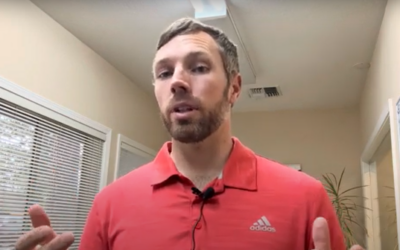This is for the very early phase of low back pain. These are exercises that what I would recommend to almost all patients whether very mild, or extremely severe. Depending on how painful the low back is, this will determine how fast you can progress through these exercises. But these are a very easy starting point, and super helpful with things like disc injuries, sprains, and pretty much anything low back related. We will get started with this so and go over a progression and if any point this gets painful or you are not able to perform the movement well, I want you to move it back a step. If you can perform the activity without pain and with good positioning, move forward.
Starting off I want you to lay on your back with knees up and feet on the ground. First step is breathing. As you breathe that stomach should be able to move up towards the ceiling. As you can see, the belly should come up and the chest shouldn’t really move at all. The way that she’s doing it right now, is really good and I want it to be comfortable in that position. This is the type of breathing you should be doing when you’re sitting, watching tv, on the computer, or anything really simple. The diaphragm breathing should come from here. Once you get started and comfortable here, the next phase would be really small lifts with the legs. As you breathe out, lift the leg just barely off the ground, like an inch or so off the ground. Part of this phase is answering the question of can you breathe and move at the same time. Also, can you maintain a good position while you’re breathing. The first thing that you want to look for here is if lifting one leg is painful? It should not be. If it is, move back to that breathing and get better at that movement. The other part of this is while you’re doing this movement, I want you to focus on if one side is easier to move than the another, maybe heavier feeling or just smoother on one side. You may notice when you lift one leg that that shoulder will come off the ground. For example, if she is lifting her left leg typically that right shoulder will start to move. She will slightly rotate a little bit through the torso. That would be a bad example when that shoulder comes off the ground. The next phase would be if that feels comfortable go to the next stage.
Now instead of lifting just barely off the ground you’re going to move that leg straight out, and then back up. Same thing on the other side. It may be painful because this is creating a little bit more tension in that abdomen and core region. If you can’t maintain that good position, you’re going to arch in that back and you’re going to create more tension and possibly pain in the low back as well as a faulty pattern. This should be comfortable. This is a little bit more difficult than the one before.
The next phase would be lifting both legs off the ground, hips at 90 degrees and knees at 90 degrees. Already, this is creating a lot of core muscle activation just holding this position. This may be your early phases in low back pain, and this alone might be painful so we want to work up to this point. Throughout this process you should be maintaining breathing through your core. Now you’re just going to take one leg at a time and touch down to the ground and back up. And same thing on the other side. The same rules apply, if you can maintain breathing through your stomach or belly, and not move breathing up to the chest, you are doing the movement well. A really common concern is that as soon as you start creating tension in that torso, then you’re going to have to breathe through the chest. This is a common habit we are trying to get out of. This whole time you are trying to build stability in your low back.
Next step is you are going to take that leg and straighten it out instead of touching down. And the repeat on the other side. So again, focus on which side is more difficult. Each step has been getting harder and harder. If you are able to maintain a good position here, all of these progressions should be fairly easy.
If this is comfortable, move to the next step in this position. With arms up towards the ceiling, now progress to moving the opposite arm and leg. Some of the difficulty here is just the coordination. Try to maintain a nice core position here while moving and being able to breathe properly. You haven’t really mastered an exercise unless you can do it while breathing properly.
This is going to be an important part in that low back rehab. So hopefully that makes sense. This is something I go over with pretty much all of my low back injury patients. This may not necessarily fix your problem now and forever. However, this movement is a big one that if you are not doing this well, this can cause the problem to come back again sooner. We need to get this pattern right first. Then you can get the right muscles firing and become more comfortable. As you keep moving and progressing, this will help so the pain doesn’t just come back over, and over again. If you have any questions feel free to give us a call, or email.
For more information on what you can do at home to help move better, check out our Rehabilitation articles.
Tahoe’s Premiere Sports Chiropractor
Follow us on
Facebook https://www.facebook.com/summittoshore/
Instagram https://www.instagram.com/summittoshore/





